Cactus spines and the various shades of curlew poop: a 3-week journey across Idaho, Montana, and Wyoming to capture and track Long-billed Curlews
By Jay Carlisle
I’m happy to be coordinating a huge study of Long-billed Curlews this spring across 3 states. Since early April I’ve been working with a dedicated graduate student, 9 field technicians, and countless supporting/collaborating partners in each of 7 study areas. During the first 10 days of May, our local team worked hard to capture and band 10 adult curlews in our study area west of Boise (the Long-billed Curlew Habitat Area of Critical Environmental Concern), including deploying satellite transmitters on 4 new birds. A few days later it was time for me to begin a fieldwork-oriented road trip in order to capture adults and deploy additional transmitters at our other 6 sites. I left on May 13 and returned to Boise on June 3, having visited many beautiful places and worked with many great people along the way!
1st stop, Big Creek Ranch, Pahsimeroi Valley, Idaho:
From the evening of May 13 through late afternoon of May 14, 4 of our dedicated curlew technicians (Ben, Erica, Hattie, & Sarah) assisted me in capturing 5 adult curlews and we deployed a transmitter on a new adult female. Ben had already found ~10 nests in the area by the time we arrived but on the morning of the 14th we located 3 new nests before resuming trapping – a great morning! Our newly transmittered bird, CT, joined the ranks of the other Pahsimeroi birds, Goldie and Borah.
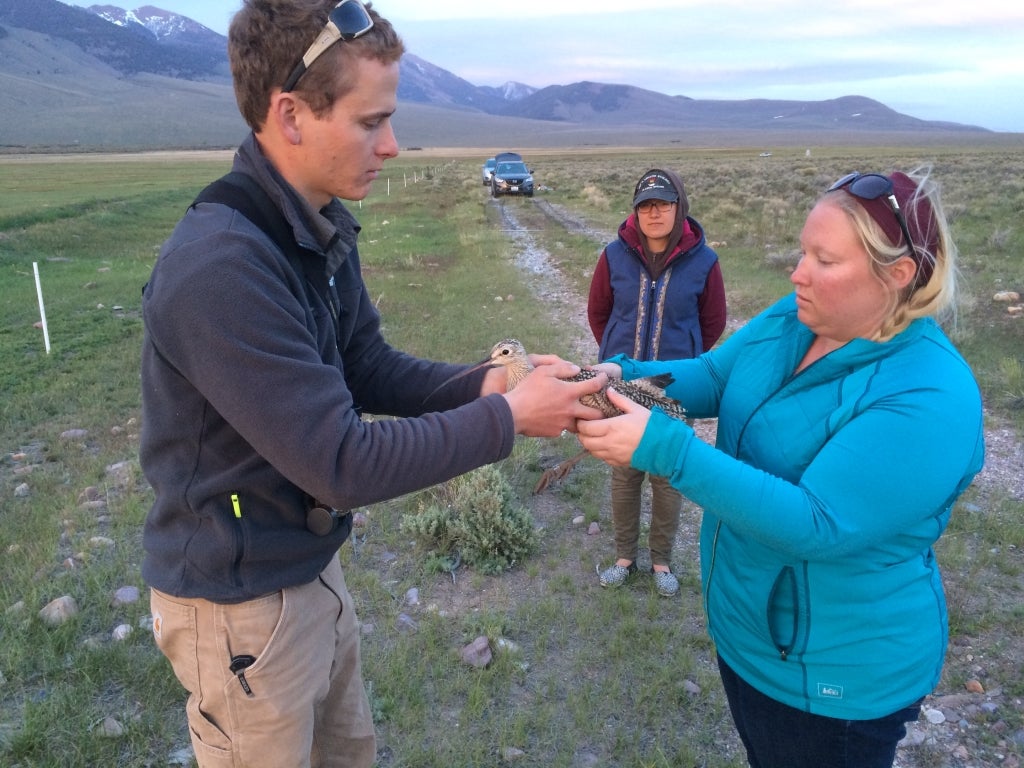
MPG Ranch, Montana:
We had initiated work at MPG during May 2014 but had disappointing/inconsistent results from the hand-me-down transmitters we deployed. In 2015 we were hoping to recapture the birds from 2014 to deploy new, more reliable transmitters. BUT, we found fewer curlews in 2015 and were only able to find 1 of the 2014 curlews (a female named “Parking Lot Dave” :-). Fortunately Sarah had been able to find her nest so, once we arrived from the Pahsimeroi, we quickly captured her and outfitted her with a shiny new transmitter! We had less luck with her mate as a storm prevented us from an early evening attempt and when we tried early the next morning, he flushed at the last second (“noooooooo!”). I had to shift focus to a point count survey training for the next 5 days (great fun in the beautiful Swan Valley of Montana) and I returned on Friday late afternoon hoping for a 2nd attempt at Dave’s mate. When we arrived to the vantage point we saw what I was afraid of (no 2nd chance to catch him) but what was also REALLY COOL to see: 2 chicks had just barely hatched and the other 2 would hatch by the next morning. So, we were treated to an across-valley view of the pair tending their newly hatched chicks! Our elation at this event was soon ruined as Sarah saw a lot of coyote activity in the nest area a couple days later and then never saw chicks again – proof that raising young curlews is a tough gig in today’s world!
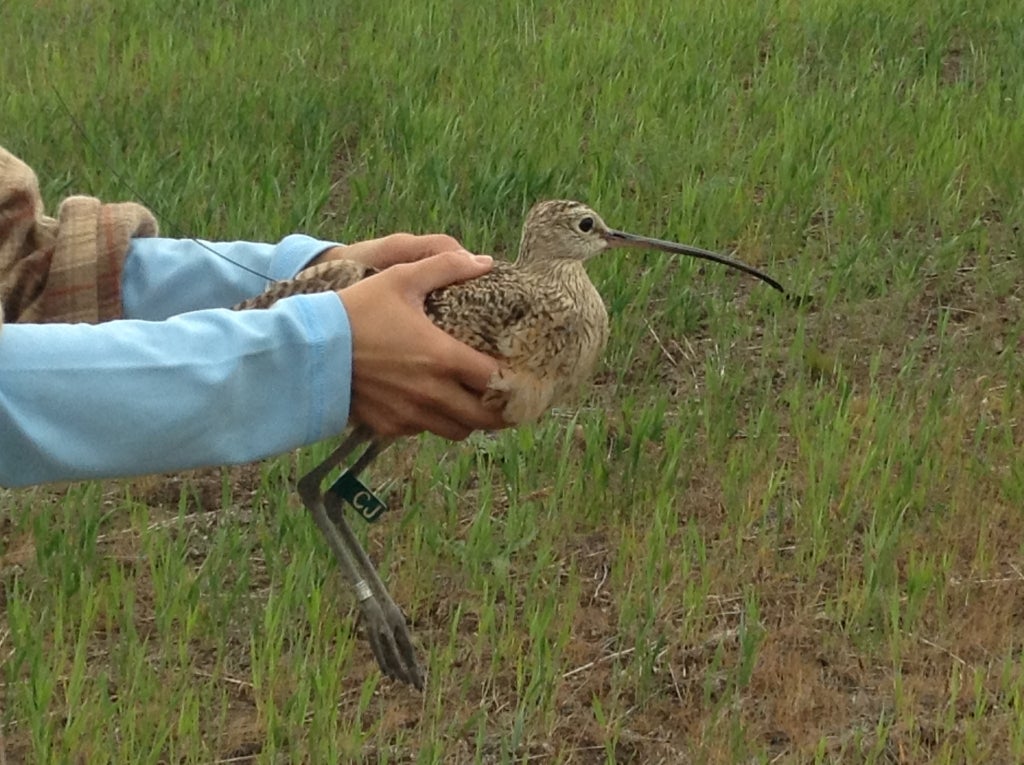
Cody/Powell, Wyoming:
After striking out on a 2nd visit to MPG, I decided it was time to head to the most distant study site – one of our new sites for 2015, situated near Cody & Powell, Wyoming.
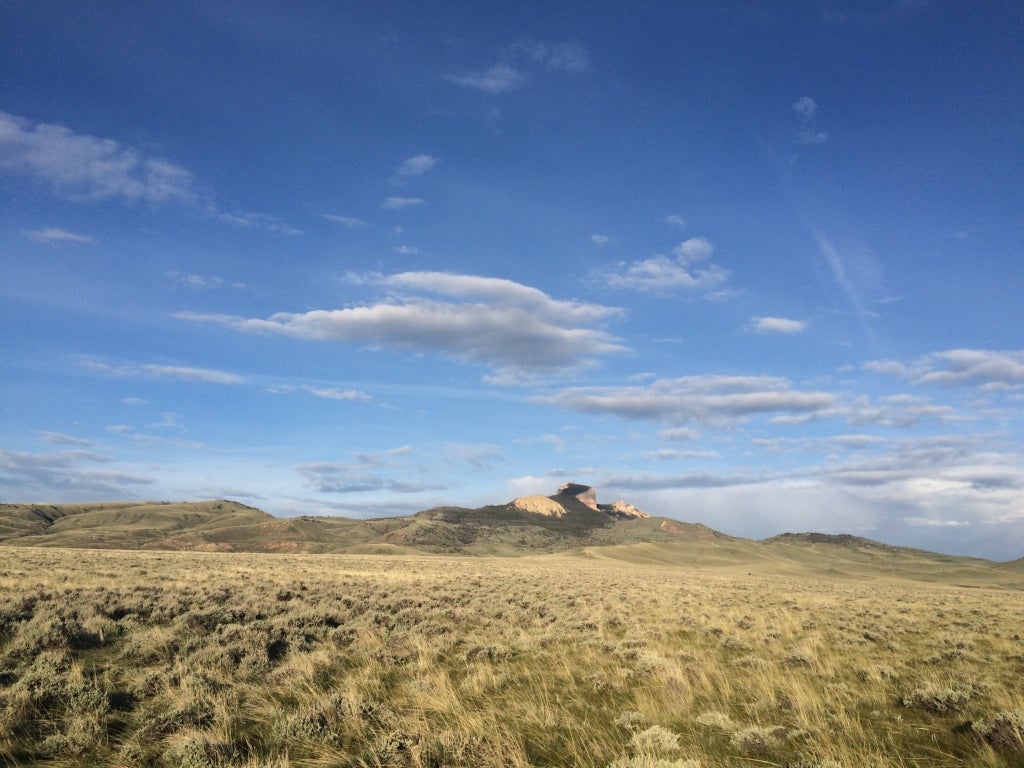
I had been here in mid-April when delivering Eric & Jeremy to the site and meeting local contacts, Brian & Carrie Peters with The Nature Conservancy’s Heart Mountain Ranch Preserve and Destin Harrell with BLM. It’s a gorgeous area that also holds some different habitat relative to our other study sites – a mix of bunchgrasses, low sage, and some cactus. These habitat features, especially the sage and tall bunchgrass, meant that this was a more difficult place in which to find nests.
In my career as an ornithologist, I have found curlews to be the most challenging species I have studied in terms of the effort/skill it takes to find their nests. They nest in the open on the ground and are thus quite wary when human observers are close (especially within ~200 yards) so we’ve learned to watch from a distance at key times of day. But this habitat increased the challenge as the bunchgrass (taller than usual because of a wetter 2014 growing season) and sage combined with the subtly rolling terrain made it really difficult to observe curlews from far away. Thus, even though Eric & Jeremy were finding moderate densities of curlews in a couple areas (Heart Mountain Ranch and the Polecat Bench area), including numerous pairs, finding nests was proving difficult. Fortunately they had found one at Polecat just a couple days before I arrived so on Monday we headed out to capture the female. This ended up being my most shocking capture experience of the season as when I knelt down to corral the female after she jumped into the net, my knee and both wrists went right into clumps of prickly pear cactus – ouch! Fortunately adrenaline didn’t let me feel the pain until after I had a solid grip on the female but I was pulling out the broken tips of spines from my knee weeks later :-) We were rewarded with some excitement when we came back a couple days later to catch and band the male – 2 of the eggs were starting to hatch and we could actually hear them chirping! Needless to say, we hurried to band and process the male as quickly as we could so he could get back to his nest ASAP.
Pipping eggs at Polecat Bench, Wyoming
We ended up being able to find 2 other nests on the slopes of Heart Mountain and thus were able to deploy the 2 transmitters we hoped to in this study area and caught 2 other adults to band and collect genetics samples. During my time in the Cody/Powell area, we had a couple other notable observations:
- Eric and Jeremy had recently noticed a large gathering area for curlews near where they were staying on the Heart Mountain Ranch – a field with a tall mix of alfalfa and grasses. We continued to see this each evening and morning and realized that many of the females nesting on the slopes of Heart Mountain were coming here for the evening/night, presumably for food and cover, and then heading back to nesting areas in the early morning.
- Another fun thing we noticed was variability in poop color :-). Previously I’d mostly seen some variation from greenish to grayish but across the 4 birds we captured in this area, we saw a wide variation – including 1 bird with mostly reddish poop. Dr. Eric Atkinson, a local colleague/collaborator teaching at Northwest College in Powell, suggested maybe it was from eating some of the numerous grasshoppers in the area and this seemed the best explanation.
Henry’s Lake area, Idaho:
With the help of TNC, in 2014 we had been able to deploy a transmitter on a female curlew at the Flat Ranch Preserve that TNC supporters voted to name Henrietta. We were excited to be able to get more details about curlews in this area in 2015 – including extensive abundance surveys throughout the Henry’s Lake basin and Shotgun Valley, nesting success information, and adding 2 more transmitters. Erica and Hattie had started the nest-searching season with a bang and one of the really cool things they documented was that 2 nests they found each had 5 eggs – something we hadn’t yet seen. One of these was Henrietta’s nest and catching her mate was a high priority once I arrived here.
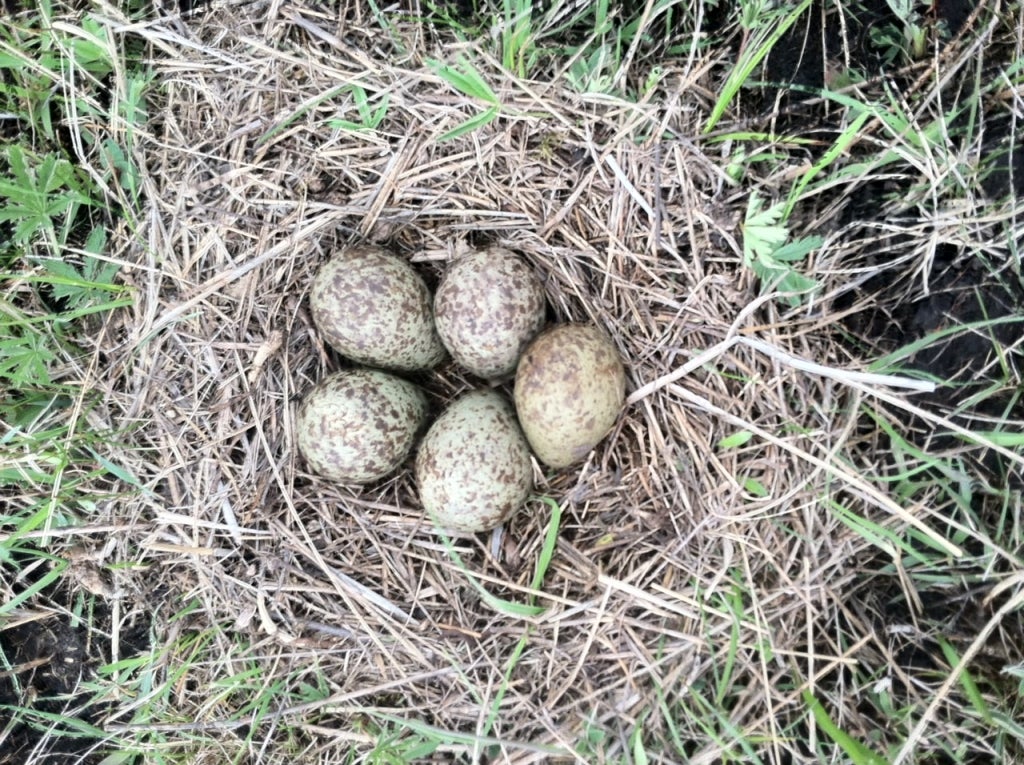
Fortunately their nest was relatively close and catching her mate proved to be pretty straightforward – thus, it was great to arrive in the afternoon and have deployed a key transmitter by nightfall!
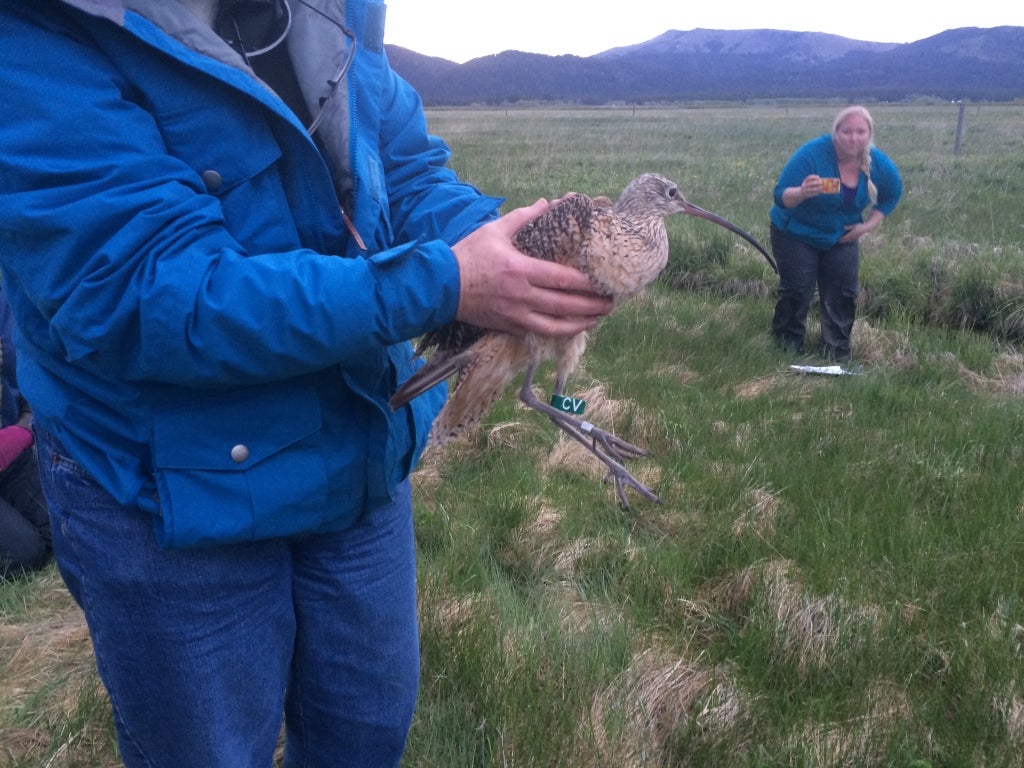
We spent the next couple of days searching for nests in the Shotgun Valley where, like over in the Cody/Powell area, sagebrush made long distance visibility difficult. Our efforts paid off and we were able to trap a female on the Trude Ranch and set her up with a transmitter. During the rest of my time here we were foiled by several rain squalls but we still ended up able to catch the birds we needed to. As with all other sites, local partnerships have been crucial to our success and enjoyment on this project – TNC, IDFG, BLM, and the local Master Naturalist chapter all played important roles in our work in the Henry’s Lake area.
Jackson, Wyoming:
In 2014 we had deployed a transmitter on a single female on the National Elk Refuge, named AJ, and she had the most unique migration of any of the curlews in our study to date – long stopovers during both fall and spring migrations and she traveled much further south in Mexico than our other tracked birds. I was excited to have funding from the Meg & Bert Raynes Wildlife Fund and the Wyoming Governor’s Association Big Game License Coalition to deploy 2 more transmitters in the Jackson area: 1 more on the National Elk Refuge and 1 on Grand Teton National Park (GTNP). I really hoped to be able to find AJ’s nest and deploy a transmitter on her mate so I was excited when Erica (who had agreed to volunteer her weekend helping me in Jackson so she could see the Tetons) found her nest! But, a combination of thunderstorms and bad luck led to a day and a half of the worst trapping success I’ve ever experienced – and had me scratching my head and pleading for luck to return! First we had a female flush very early from a nest in GTNP, likely because of some raven and raptor disturbance we saw while getting ready. Then a storm foiled our attempt to catch AJ’s mate that evening. We tried for him early the next morning and he flushed at the last second (another silent “noooooo!”). We decided to shift back over to GTNP and actually had some good luck for a spell in which we located 3 new nests (making for 4 nests plus at least one other pair from 1 vantage point – an impressive density of nesting curlews!) over the course of a few hours but then continued our bad luck in capture by failing on our first 2 attempts. Finally, on our most distant nest, we succeeded in catching a large, and fortunately cooperative, female!
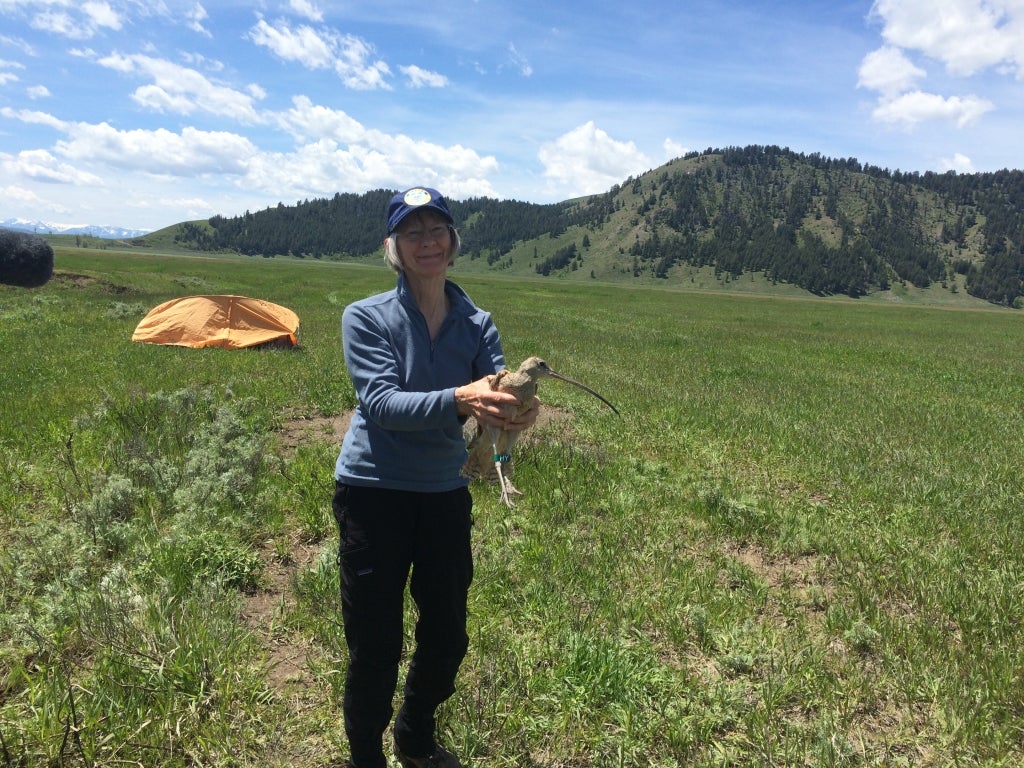
We still needed to deploy a transmitter on the National Elk Refuge and, so far, we’d only been able to find a single nest – AJ’s. Her mate was the curlew I most wanted to catch but would we be able to catch him with a 2nd attempt or would he flush early? I was stressed and unsure how best to go about it but, with council from my main partner in Wyoming – Wyoming Game and Fish Department biologist Susan Patla – decided that it’d be worth an evening attempt since maybe he’d be more likely to stick on the nest when settling in for his nocturnal incubation duties (he’d flushed in the morning when he knew AJ was around and getting ready to spell him). So I was able to quickly pull together an all-volunteer team and give it a try. Figuring I had much less than a 50/50 chance, we went for it and my heart was pounding as we approached his nest. We had the net right over the nest area but couldn’t see him so we hesitated in lowering the net … Suddenly he flushed at an angle but barely flew into the last panel of the net. “YEEEESSSSSSS!” I even did a little skip on my way in to corral him in the net as I was so relieved to have captured this guy :-). It was fun to celebrate with the dedicated volunteers that had helped, including Jennifer & husband Mike, Mark and his daughter Emmie, and Mary – all of whom had witnessed multiple failed capture attempts and were very deserving of some excitement!
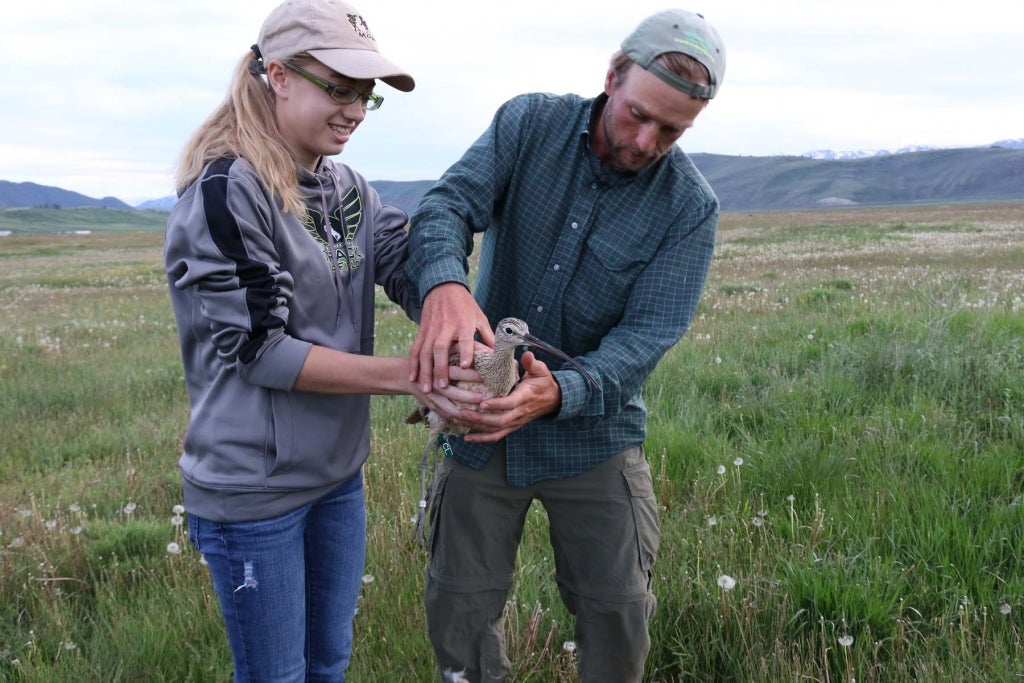
Photo by Mark Gocke
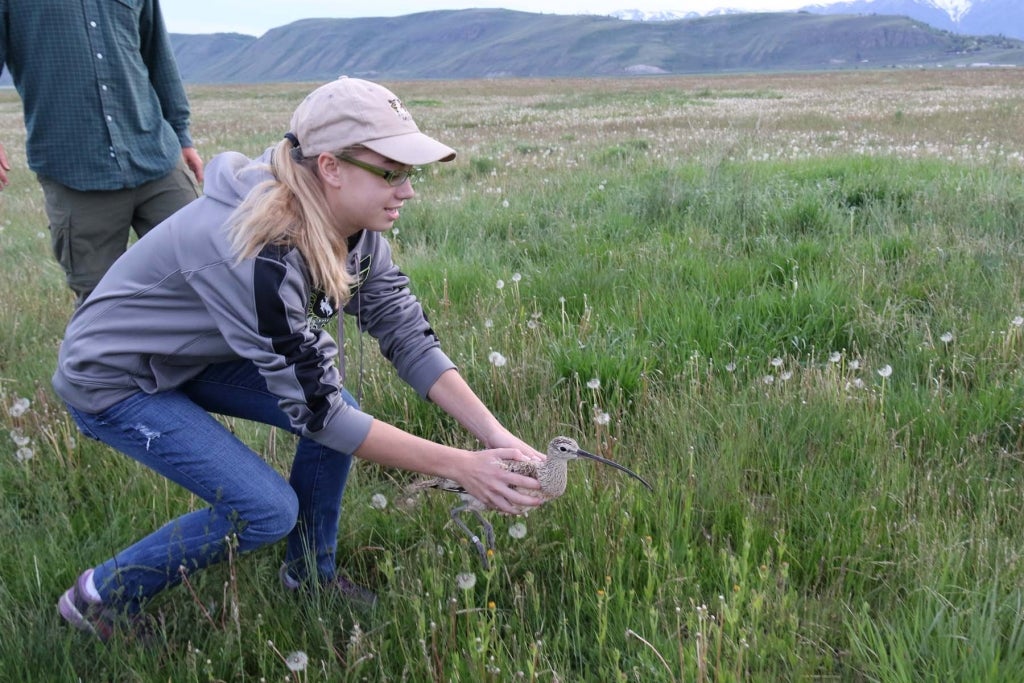
Photo by Mark Gocke
Daniel, Wyoming:
This was the last stop on my 3+ week journey and I was looking forward to seeing the curlew activity in this new-to-us study area. The flood irrigated pastures in the Daniel area support the largest known curlew population in Wyoming. This population was first studied in the early 1980s as part of a master’s thesis and our 2015 field season was an opportunity to revisit this historic study as well as deploy transmitters in a new area. I had 3 transmitters to deploy and hoped to be as efficient as possible; thus, I was none too happy when yet another thunderstorm put an end to trapping plans on my first evening in the area (June 1). I needed to get back to Boise by the 3rd so this meant the 2nd was going to be a busy day! We started around 6am for some nest searching on a ranch where the crew, Kevin & Mikki, had just recently been granted permission to search and monitor. It was a happening first couple hours as we found 4 new nests, including 1 that was hatching that morning! We didn’t finish work until almost 9pm, after capturing 5 adult curlews and deploying transmitters on 2 females and a male – possibly the most productive day on this curlew study for me with 4 new nests and 5 birds captured. It was an epic day during which I appreciated the hard work of my field technicians and my colleagues with Wyoming Game & Fish as well as the interest and enthusiasm of several private landowners I was able to meet.
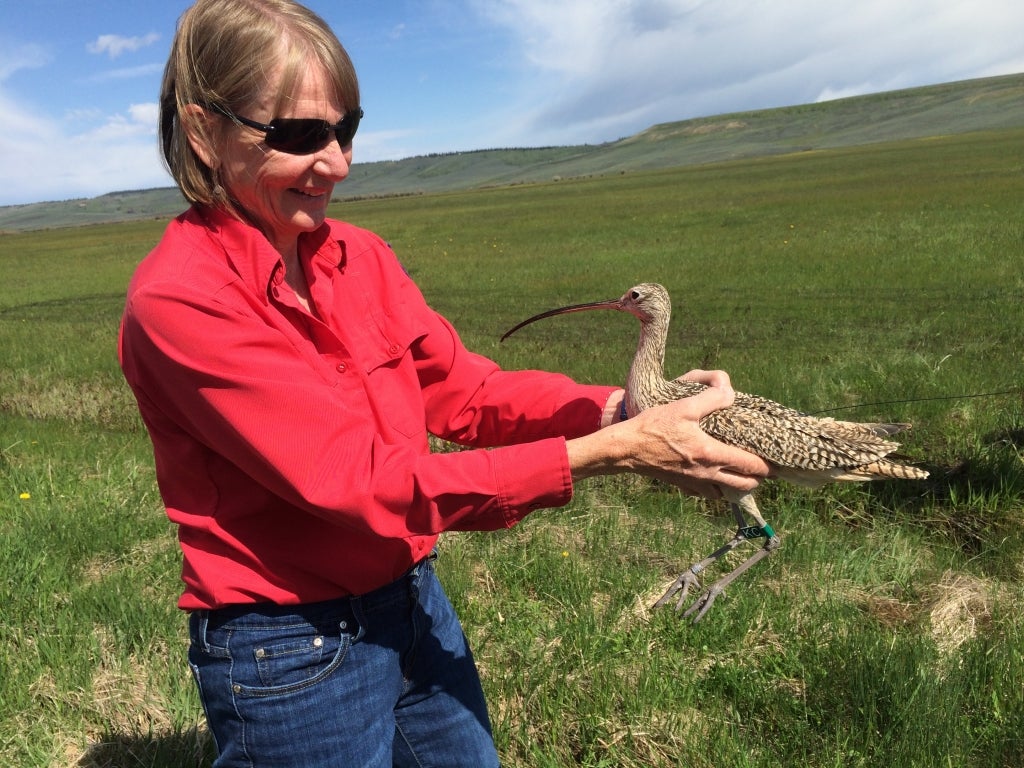
Photo by Jay Carlisle
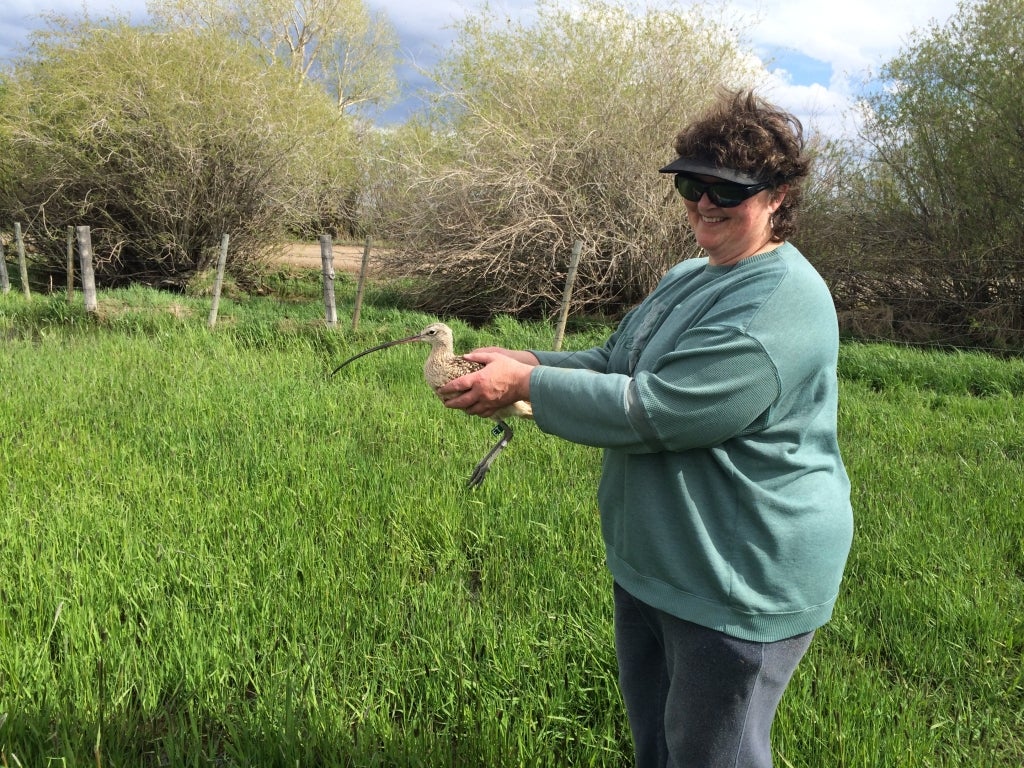
Photo by Jay Carlisle
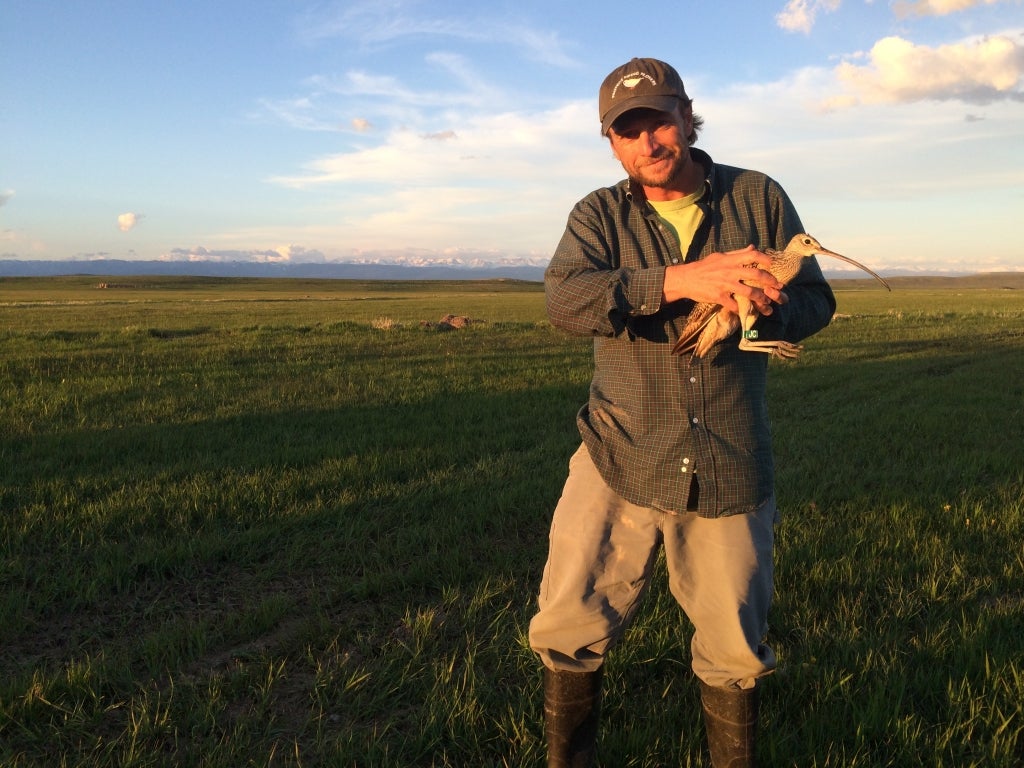
Now we get to sit back and do “armchair biology” by watching where these birds go.
